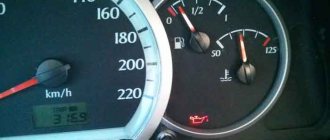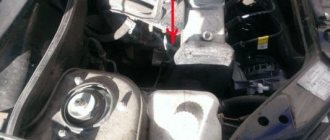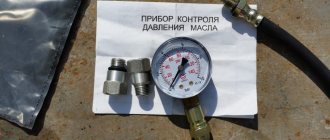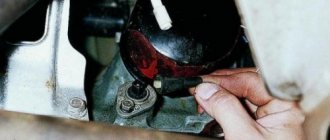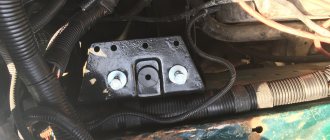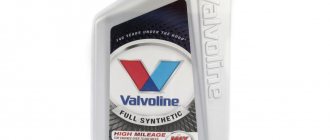HELPFUL ADVICE If you don't have a funnel to add oil, you can use a funnel made from the neck of a plastic bottle.
7. Start the Lada Priora engine. If, at a normal level, the emergency oil pressure drop lamp goes out, you can continue driving. If the lamp does not go out, check the serviceability of the oil pressure sensor. It is mounted at the top of the rear of the camshaft bearing housing. Unscrew the standard oil pressure sensor and install a mechanical pressure gauge in its place. If at normal idle speed the pressure is more than 0.1 MPa (1.0 kgf/cm2) and increases with increasing speed, the oil pressure sensor or its electrical circuit is faulty.
USEFUL ADVICE If you do not have a pressure gauge, all that remains is to check the reliability of the contact in the block with the sensor wires or replace the oil pressure sensor with a known good one.
If, after eliminating all visible causes, the oil pressure in the engine is insufficient (the emergency oil pressure drop lamp is on), diagnose and repair the engine (see Section 5 “Engine”).
WARNING Do not attempt to drive to the garage; the engine will be damaged. Tow the vehicle with the engine not running for repairs.
The main reasons for the oil pressure warning light to come on
So, the warning light usually lights up after starting the engine or when it is idling. There may be several reasons for this phenomenon, but the main thing is to understand and accept for yourself that this should be a signal that there is some kind of malfunction. Therefore, you need to take appropriate measures so as not to worsen the situation. In any case, if the lamp blinks, it means that you need to identify the malfunction and do everything to eliminate it as soon as possible.
Among the main reasons for the indicator to light up are the following:
- Reduced lubricant pressure in the system. This is one of the most common reasons, but even today there are owners who stubbornly do not notice signs of oil leakage or do not look into the engine compartment. Why does pressure drop, you ask? Because the oil gradually leaves the system. Therefore, you should pay attention to any stains on the engine or under the car where it is parked. Do not forget that by simply adding lubricant to the system, you do not solve the problem, but only forget about it for a while.
- Another reason for the warning light to blink is due to the use of low-quality oil filters. Some of the lubricant remains in them even when you stop the engine. If the filter is of dubious quality, then it does not retain oil, but it directly flows into the crankcase. Thus, a periodic drop in pressure occurs.
- Lack of lubrication may be associated with failure of the pressure relief valve. It should be in the closed position if the pressure level in the system is insufficient. However, when the valve fails or gets stuck, the pressure generated is not enough, which causes the warning light to light up.
- Another reason is a faulty pressure sensor. It is directly related to the operation of the control indicator, since it is connected to it by the same wire. As soon as the pressure returns to normal, the contacts should open, as a result of which the indicator should go out. This will not happen if the sensor itself has become faulty.
- The indicator also starts blinking if the oil pump screen is clogged. It acts as an obstacle to particles of dirt, metal, dust and any other unwanted elements that lead to wear on the pump. If the oil is not dirty, but of normal quality, then it freely penetrates through the mesh. When it is contaminated, the required pressure is not created in the system, which leads to the warning lamp coming on. Most often, this reason manifests itself on a cold engine, because as it warms up, the lubricant becomes more liquid and passes through the mesh much more easily.
- The oil pump itself may also fail. It is this that creates an acceptable level of pressure in the entire system. If this does not happen, the sensor contacts close, which leads to the appearance of a signal indicator on the panel. Therefore, in this case, you will have to dismantle the oil pan and pump to eliminate the problem.
The oil can blinks: reasons
Why is the oil pressure light blinking? There may be many reasons, but not so many that they cannot be grasped by consciousness. But a very important point is the sequence in which these reasons will line up in your head! The speed of troubleshooting, and the amount of “weight loss” in your wallet, depends on this.
So the oil pressure light is blinking. First of all, you need to immediately turn off the engine. Raise the hood. Wait about ten minutes, allowing the oil to drain into the engine crankcase. Check the oil level: according to the engine operating instructions, it should be in the middle (but can be a little higher), between the Min marks. and Max. If the oil level is normal, you need to calmly think about the possible reasons for the blinking oil pressure light.
What could be the reasons:
- Oil level.
- Lubricant quality.
- Loss of oil through gaskets and seals.
- The pressure sensor is acting up.
- Oil pressure sensor wiring.
- Oil filter.
- Pump.
For now, these are the reasons that are most accessible to clarification, and if they are not the culprit that the oil pressure light is blinking, then the matter is taking a serious turn.
First, let's look at methods for identifying these causes and ways to eliminate them.
How does the oil sensor work and why can it fail?
Now let's consider the situation if you are on the road and the low pressure indicator has triggered. The very first thing you need to do is stop the vehicle and turn off the engine. As soon as it cools down, you will have to check the lubricant level in the system. There is a special dipstick under the hood for this purpose. It is wiped dry and immersed in its original place. It is quite possible that the level will be below the minimum level. This means that somewhere there is a leak or depressurization of connections. You can set off again only after adding oil to the engine. If the lamp continues to light after starting and does not go out subsequently, it makes sense to think about towing the car to the nearest service station or to a trusted auto mechanic. The matter may turn out to be quite serious, so it is advisable to conduct the examination in a calm environment.
Since we have already said that the causes of low pressure may be associated with a faulty sensor, it would be useful to understand the principle of operation of this device. There are certain contacts inside it. Until the ignition is turned on, there is no pressure in the system, so the contacts are closed. When you turn the key and turn on the ignition, but before the starter starts, the warning lamp should be on. If this does not happen, then there may be some kind of malfunction. Maybe the light bulb itself simply burned out, or maybe the contacts were broken or the sensor itself failed. As soon as we start the engine, the contacts open, leading to the light bulb going out.
Method for properly checking engine oil level
There are rules for checking the engine oil level:
- Tracking is performed strictly on a horizontal platform.
- The oil level is checked at a temperature below normal engine heating (allow to cool slightly).
There are foreign-made engines where the oil level can be checked both “hot” and “cold”. In this case, the manufacturer provides the “cold” and “hot” labels, respectively.
How to check pressure
If it is not possible to contact a car service in the near future, you can try to find the cause yourself, and for this we need to find out how to check the oil pressure. A special device that measures the pressure in the system is designed for these purposes. It is sold ready-made or you can make it yourself based on any pressure gauge, a rubber hose with a fitting, the thread of which should be the same as that of the oil sensor.
First you need to unscrew the thread on the sensor, preparing for the fact that oil will immediately begin to flow. After this, a pressure gauge is inserted into the system and the engine is started. At the time of startup, a second person must watch the instrument readings. If the value is less than 0.5 kg/cm2, it is necessary to stop the engine.
Level below normal
The minimum oil pressure in the system of a working engine is: 0.7 - 0.8 atm. at idle, and 3 - 4.5 atm. on power. If, when checking, the level turns out to be lower than expected, this may be the cause of a drop in pressure due to “oil starvation”. In this case, you need to find out the reason for the drop in level; there may be several of them.
You need to carefully inspect all joints for oil leaks. Pay special attention to:
- oil filter mounting location;
- pressure sensor;
- oil seal installation locations;
- places where the covers are attached (front and rear), along the perimeter of the valve cover and engine crankcase installations.
Also check the front lower part of the gearbox for leaks; oil leakage in this place indicates a failure of the engine crankshaft rear oil seal. You need to add oil to medium level. If, after starting the engine, the blinking of the light stops, you can drive to the nearest place for diagnostics and, if necessary, repairs.
Gas distribution and crank mechanisms
Well, now to the most serious and extensive reason, from which my head begins to buzz, and the above reasons are not considered anything in comparison with this one.
This is wear of the liners on the timing shaft cushion and on the crankshaft journals, wear of the oil scraper rings on the piston group, deterioration of the cylinder walls, etc. From this moment on, the matter takes on the shape of a major overhaul.
All of the above applies in general to our VAZ classics, and the question of what to do if the oil pressure light on a VAZ is blinking has been given an exhaustive answer. But there is one small addition regarding Priora.
Oil pressure light blinking in Peugeot
Fans of the “French” also “have not passed away.” But a couple more links are built into the chain of causes: the oil filter has a plastic partition in the shape of a cross, which often breaks and a fragment blocks the valve, creating “oil starvation.”
Another reason may be incorrect operation of the solenoid (solenoid) valve for regulating the oil pressure. Often the sealing sleeve, which is located at the entry point into the cylinder block housing of the electrical wiring suitable for the solenoid valve, fails. Due to the loss of elasticity of this part, oil leaks at the place of its installation.
Checking oil pressure
Checking the oil pressure is carried out to determine its true value on the scale, and to determine the serviceability or failure of the sensor. This requires a pressure gauge with a connected oil-resistant hose, at the end of which there is a threaded fitting whose diameter is equal to the diameter of the sensor thread. The specified sensor is unscrewed and a fitting with a pressure gauge hose is inserted in its place. Then the engine starts.
First, the pressure is measured at idle, then at medium speed, recording the readings of each mode. If the pressure parameters are normal, but the light blinks at idle, you have to blame the sensor. To eliminate doubts, the condition of the contacts in the electrical circuit is checked, and, if necessary, the oil sensor is changed.
"Unfortunate Wind" "Priors"
The Priora engine is not distinguished by any super-revolutionary innovation, and all the “sores” regarding “oil starvation” are inherent in it too. But as we know, the motor is located perpendicular to the longitudinal axis of the car. Due to the geometric configuration of the engine compartment, the jets of incoming air flow around the engine in such a way that sometimes they create an unnecessary headache.
Quite often you can hear that the oil pressure light on a Priora is blinking because dirt (snow, rain) has gotten on the sensor. In such cases, it is enough to clean it of dirt and wipe it dry. Here it makes sense to make a protective screen for the sensor.
Level above normal
Well, what if the oil level is higher than normal? Here the reasons should be sought in a different direction. Most likely, the viscosity of the lubricant will also be lower than that specified for engine operation. So what could be the reason?
One of the probable reasons is the ingress of coolant into the oil system due to burnout of the jumpers in the gasket between the valve head and the engine cylinder block. Liquid from the cooling system enters the engine crankcase through the burnt area. A mixture of coolant and oil is formed, the viscosity of which instantly drops, as a result of which the oil pump is unable to create the required pressure. Also due to cracks and microcracks that appear as a result of engine overheating.
Using low-quality fuel can lead to the same result. Burning not completely in the combustion chamber, it enters the crankcase through leaks in the piston rings.
There is another possibility of fuel getting into the crankcase: from the cavity of the fuel pump. The cause may be membrane failure.
The likelihood that the rubber seals will collapse and the tightness of the system will be compromised is high when replacing mineral oil with its synthetic analogue or vice versa. Different brands of oils vary in temperature resistance. For example, at low temperatures it becomes highly viscous, and at high temperatures it becomes too liquid. We should not forget about the existence of oils manufactured in violation of technical specifications. When choosing a lubricant, you need to carefully study all its characteristics.
If the oil pressure light blinks at idle, then you should check the true value of oil pressure.
Checking the oil filter
Next we move on to checking the oil filter. It is possible for a foreign object (metal shavings, debris, etc.) to get under the shut-off valve, preventing it from closing. As a result, when the engine is stopped, the lubricant from the filter flows into the crankcase. Upon subsequent startup, the oil pressure light blinks at idle until the filter is refilled. The filter itself may also be clogged, preventing sufficient pressure from being created.
